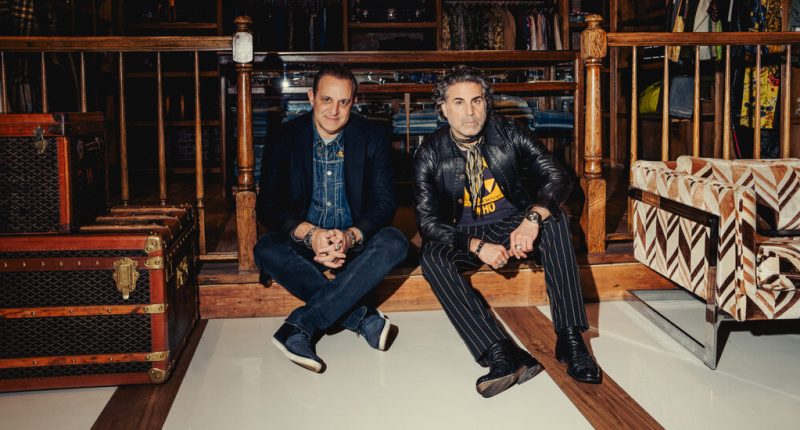
On a recent afternoon in SoHo, Seth Weisser and Gerard Maione were checking in on their shop, What Goes Around Comes Around, a luxury vintage boutique on West Broadway that has long been a downtown destination for stylists and celebrities.
They stepped past Jean Paul Gaultier shirts from the late 1980s and Harley-Davidson biker jackets from the 1960s before entering the area containing their vast Levi’s collection. Mr. Weisser, who was wearing a vintage Hermès jacket, gingerly took hold of a pair of 1950s-era jeans. The price was $3,000.
“These might look like ordinary Levi’s, but the denim connoisseur who sees someone wearing these is going to know exactly what they are,” he said. “This is the beginning of quiet luxury.”
One of their regular customers, Stefon Diggs, a wide receiver for the Buffalo Bills, was browsing near a mannequin holding a quilted Chanel purse made in the 1990s.
“You beat my Jets yesterday,” Mr. Maione called out.
“Yeah, but you guys beat us last time,” Mr. Diggs replied.
Mr. Diggs ended up buying two Chanel purses. Outside the store, a friend took pictures of him modeling his purchases in front of an S.U.V.
“I’ve been shopping at What Goes Around Comes Around for a long time,” Mr. Diggs said, mid-pose. “I like vintage because it’s timeless, so I like to stack up on it here.”
Mr. Weisser, 56, and Mr. Maione, 55, grew up in neighboring towns on Long Island. Mr. Weisser’s mother was a gym teacher, and his father was a lawyer; Mr. Maione’s family ran an Italian deli.
The two men became friends at Syracuse University in the late 1980s. They began thrifting at street fairs and flea markets in the 1990s, when they learned that their best shot at getting into Manhattan nightclubs like Spy Bar was to have a slick look.
The hunt for vintage became their obsession. At a rag house in the Bronx, they filled trash bags with rock concert T-shirts and a pair of Levi’s made during the Eisenhower administration; at the Rose Bowl parking lot in Pasadena, Calif., they bought rare denim from the backs of vans.
They opened What Goes Around Comes Around in 1993. In those days, secondhand meant second-rate to much of the fashion set, and the duo saw themselves as downtown entrepreneurs whose mission it was to preach the gospel of vintage.
“The stigma was that people felt it was beneath them to buy something used,” Mr. Weisser said, “but we saw wearing vintage as giving someone individuality.”
Their first regulars included Jean Paul Gaultier and Carolyn Bessette-Kennedy. Stylists for “Sex and the City” found outfits there for the show’s star, Sarah Jessica Parker, who became a client herself.
“New York has a long history of vintage, but it’s the way they pursued pieces with legacy that always made them stand out,” Ms. Parker said. “There will be only one of something there, not multiples of it. And that’s when vintage gets really special.”
“They’re not the RealReal,” she added. “What they do feels a little more rarefied. Sometimes you have to be a bit of a fashion historian to understand what they have, but it’s worth the effort.”
After three decades in business, What Goes Around Comes Around has an outpost in Beverly Hills and a recently opened second boutique in SoHo. Its customer base includes Kendall and Kylie Jenner, Lenny Kravitz and Kate Moss. Items now on sale include a Hermès “pochette” purse ($34,500), a Chrome Hearts alligator zip pouch ($3,500) and a leather Christian Dior cap ($775).
In recent years, as high-end vintage wear became a booming business, Mr. Weisser and Mr. Maione found themselves competing against the venture capital-backed consignment platform the RealReal, the online marketplace Vestiaire Collective and other similar businesses.
To bolster their e-commerce division, they recently started an online shop, in partnership with Amazon, and began producing a livestream shopping series hosted by the handbag historian Mason Howell. Episodes have included “Gossip Girl Style” and “Inspired by Priscilla Presley.”
“In terms of all our online competition, we were a bit late to the game in chasing that idea, so we’ve had to decide how to differentiate ourselves,” Mr. Weisser said.
Mr. Maione offered the opinion that their rivals buy more indiscriminately. “Lots of the stuff is fluff,” he said. “We curate to a very high level, and the only closets we’re going into are ones that we know have pinnacle pieces.”
“That’s why we get the stylists and the celebs,” he continued. “Because they know they’ll be the only ones out there wearing something if they’ve gotten it from us.”
They also reflected on a less obvious edge they might have on the competition: their decadeslong friendship.
“We’ve been through a lot together, from recessions to 9/11,” Mr. Maione said. “But we always have each other.”
Their bond, they said, helped them endure a painful downsizing during the pandemic that forced them to close locations in Miami, East Hampton and the Upper East Side. Since 2018, they have also been in litigation with Chanel, which sued What Goes Around Comes for trademark infringement, an allegation they deny. (Chanel, which has an uneasy relationship with the luxury resale sector, sued the RealReal that same year.)
When asked how they hunt for vintage clothing these days, Mr. Weisser and Mr. Maione said the particulars of acquisition are trade secrets, but allowed that they make visits to the closets of a stylish eccentric on Central Park South and that they take regular trips to the Paris flea market at Saint-Ouen-sur-Seine.
“We still fight to get into the best closets,” Mr. Weisser said. “The hunt is what keeps us going.”
As evening approached, the duo drove through the Holland Tunnel toward their 35,000-square-foot warehouse office in Jersey City. They entered by freight elevator and made the rounds of cavernous stockrooms filled with boxes of Rolex watches, bundles of 1970s rock concert T-shirts and towering piles of Louis Vuitton monogram bags.
They paid a visit to their e-commerce team and greeted a member of their authentication division, who was examining a Gucci bag with a magnifying glass for any signs of sophisticated fakery. Then they stepped into a room filled with heaps of Levi’s.
Mr. Maione ran a hand across a pair of jeans with a few tears in the fabric.
“It’s getting harder to find the old Levi’s stuff,” he said. “There’s not much of it left out there now. The source of it is all drying up. But denim never goes bad. It only gets better.”
Source: | This article originally belongs to Nytimes.com









